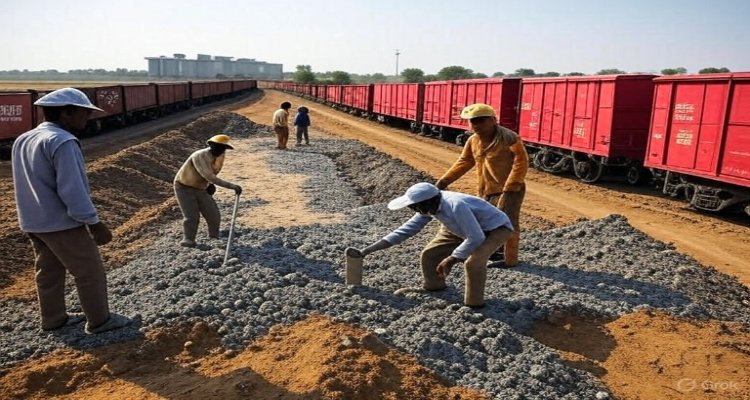What is Fly Ash? India’s Push for Sustainable Utilization of a Power Sector Byproduct
Fly ash, a coal byproduct, is transforming India’s infrastructure. Here’s how government, industry, and policy are driving its sustainable use.
Introduction: Turning Waste into Opportunity
Every year, India’s coal-fired power plants generate millions of tonnes of fly ash—a fine, grey powder once seen as an environmental burden. Today, however, this byproduct is increasingly being viewed as a resource central to building sustainable infrastructure. From cement to roads, bricks to mine backfilling, fly ash is reshaping industries while addressing waste management challenges.
On August 25, the Ministry of Railways and NTPC convened a national conference in Noida to chart a roadmap for fly ash utilization and transportation. The event brought together policymakers, power producers, builders, and logistics providers, signaling India’s strong push toward sustainable management of this industrial byproduct.
Context & Background: The Science Behind Fly Ash
Fly ash is generated when powdered coal burns in thermal power plants. It travels with boiler flue gases and is captured using Electrostatic Precipitators (ESP). India’s modern plants now produce high-quality fly ash—low in sulfur and unburnt carbon—making it suitable for multiple industrial applications.
Chemically, fly ash is composed primarily of oxides of silicon, aluminum, iron, and calcium, with traces of magnesium, sodium, and sulfur. Based on composition, it falls into two main categories:
- Class C (High Calcium Ash): Derived from sub-bituminous coal, containing more than 20% calcium oxide.
- Class F (Low Calcium Ash): Derived from bituminous or anthracite coal, containing less than 10% calcium oxide.
This classification determines how fly ash interacts in materials like cement or asphalt. Its spherical particle shape also improves fluidity in concrete mixes, flowable fills, and road surfacing, making it a valuable material in modern construction.
Main Developments: India’s Fly Ash Utilization Drive
The Noida conference comes at a time when India is intensifying its commitment to a circular economy—ensuring industrial byproducts are reused rather than wasted. In 2024–25 alone, India generated 340.11 million tonnes of fly ash, with an impressive 332.63 million tonnes successfully utilized across industries.
Breakdown of usage in 2024–25:
- 32% in road and flyover construction
- 27% in the cement industry
- 14% in bricks and tiles manufacturing
- 11% for mine backfilling
- 10% for other forms of backfilling
These figures highlight a growing trend: what was once an environmental liability is now a driver of cost savings and green growth.
Expert Insight: Balancing Challenge and Opportunity
Industry experts emphasize that while fly ash has enormous potential, sustainable handling is key.
“Fly ash management is not just about waste reduction; it’s about resource optimization,” said an NTPC official at the conference. “Our focus is to integrate fly ash into mainstream industrial supply chains, ensuring efficiency, affordability, and environmental responsibility.”
Environmental analysts also stress the importance of safe handling. Fly ash contains trace metals that, if improperly stored, could contaminate soil and water. Policies mandating dry ash collection and utilization systems at power plants are crucial to mitigating these risks.
Impact & Implications: From Railways to Real Estate
The Ministry of Railways’ involvement underscores the importance of transportation in scaling up fly ash usage. Large volumes need to be moved efficiently to cement factories, road contractors, and brick manufacturers across India. Railways can serve as the backbone of this distribution network, reducing both costs and carbon footprint compared to road transport.
For the construction sector, fly ash offers a double benefit: reduced material costs and enhanced durability of structures. Roads built with fly ash blends are known to resist cracking and require less maintenance. For the cement industry, substituting fly ash for clinker lowers carbon emissions, supporting India’s climate goals.
Looking ahead, wider adoption in 3D-printed housing materials, eco-friendly tiles, and geopolymer concrete could expand its role in green infrastructure.
Conclusion: A Future Built on Circular Economy Principles
India’s fly ash story reflects a broader shift: treating industrial byproducts not as waste, but as assets. With government policies, industry innovation, and railway-led logistics, fly ash is positioned to fuel sustainable growth across construction, energy, and infrastructure.
The challenge lies in maintaining safe handling practices while scaling up utilization. If successful, fly ash could become a symbol of how India turns environmental challenges into opportunities for progress.
Disclaimer: This article is intended for informational purposes only. It summarizes developments in India’s fly ash utilization and should not be considered professional engineering or environmental advice.











